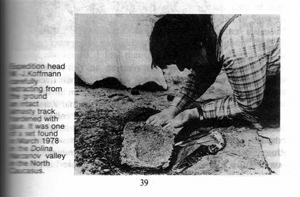December 14, 2005
Lifting a Bigfoot track
Cryptomundo is still evolving and hopefully soon there will be a place where ideas for future postings can be submitted by the readers…but for now here is Brian. He writes:

“Hey Rick, Any idea on what type of glue should be used to pull a cast like this? I think it would be cool to do this with the next track i can cast. Maybe a clear resin poured thin, i dont know i would think whatever is used it would really need to soak into the dirt. Maybe injecting into he soil also? Also any luck with my video yet? Brian”
I have been asked a couple of times now how one could lift a whole track from the ground instead of casting it. I am not sure what type of glue was used in the picture he submitted above nor the stuff Don Abbott used at Onion Mt., California back in 1967. I thought about how I would do this and this is what I came up with:
1. First, the track must not be very wet or moist. The stuff we are going to use doesn’t like water. It also kicks faster with heat.
2. You need to get some boat resin. Polyester with a red peroxide catalyst (some liquid wax in the mix might be nice too). You definitely don’t want to get any of this on your skin or in your eyes.
3. Then you will need some Acetone. This is a very flammable liquid and is carcinogenic so take care and use the appropriate type of gloves.
4. Get an atomizer for this concoction, which is probably going to get destroyed in the process. The spray is going to soak the track area with the resin mix. The atomizer cannot have any plastic inside that will melt with acetone, so you will have to check with the manufacturers on that.
5. Mix the resin and catalyst properly, add the wax if you have it and then add the acetone until it is pretty watery. This is the same way you would protect plywood on boats; painting it with this typr of resin mix. The wax should help release any casting done with it later.
6. Load the atomizer and soak the track by spraying a few feet above it, letting the mist settle evenly and without much impact.
7. It will take a couple of hours for it to set up, but when it does it should have soaked down through the substrate and set itself.
8. Lift carefully out of the ground. I usually lift a cast by digging a small trench around it then small twists of the plaster should break it free from anything still holding it down. Twisting gives it a bit more strength because of the mass in that direction versus just pulling agaisnt gravity.
I might do some experiments with this method and report on the results here if there is a real interest. This method could elliminate the need to produce a quality rubber mold of a track. Who knows? But thanks Brian for asking.
 About Rick Noll
About Rick Noll
Rick Noll has been actively searching for the Sasquatch since 1969 and continues his pursuit with extended field trips into the Pacific Northwest's most remote regions. Rick has worked with Peter Byrne, René Dahinden, Grover Krantz, John Green, Jeff Meldrum and the BFRO during all this. He helped with many documentaries on the subject including Animal X: The Skookum Expedition and Sasquatch: Legend Meets Science.
Email • Twitter •
Filed under Bigfoot, Bigfoot Hunter, Cryptozoology, Evidence, Sasquatch

